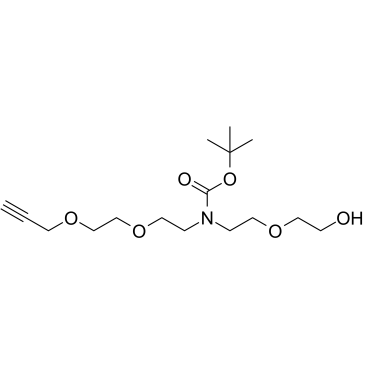N-(PEG1-OH)-N-Boc-PEG2-propargyl
Modify Date: 2025-09-13 12:43:59

N-(PEG1-OH)-N-Boc-PEG2-propargyl structure
|
Common Name | N-(PEG1-OH)-N-Boc-PEG2-propargyl | ||
|---|---|---|---|---|
| CAS Number | 2100306-85-0 | Molecular Weight | 331.40 | |
| Density | N/A | Boiling Point | N/A | |
| Molecular Formula | C16H29NO6 | Melting Point | N/A | |
| MSDS | N/A | Flash Point | N/A | |
Use of N-(PEG1-OH)-N-Boc-PEG2-propargylN-(PEG1-OH)-N-Boc-PEG2-propargyl is a PEG-based PROTAC linker that can be used in the synthesis of PROTACs[1]. |
| Name | N-(PEG1-OH)-N-Boc-PEG2-propargyl |
|---|---|
| Synonym | More Synonyms |
| Description | N-(PEG1-OH)-N-Boc-PEG2-propargyl is a PEG-based PROTAC linker that can be used in the synthesis of PROTACs[1]. |
|---|---|
| Related Catalog | |
| Target |
PEGs Alkyl/ether |
| In Vitro | PROTACs contain two different ligands connected by a linker; one is a ligand for an E3 ubiquitin ligase and the other is for the target protein. PROTACs exploit the intracellular ubiquitin-proteasome system to selectively degrade target proteins[1]. |
| References |
| Molecular Formula | C16H29NO6 |
|---|---|
| Molecular Weight | 331.40 |
| InChIKey | YEBWOLWOJRIJNN-UHFFFAOYSA-N |
| SMILES | C#CCOCCOCCN(CCOCCO)C(=O)OC(C)(C)C |
| MFCD30730381 |